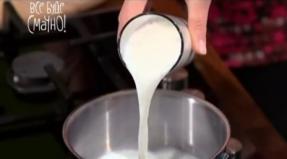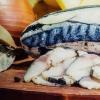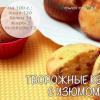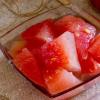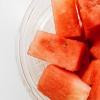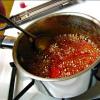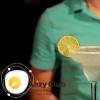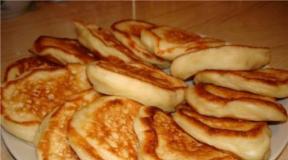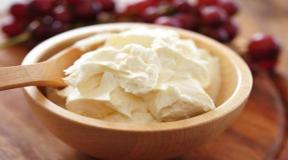Food preservative E235 Natamycin (pimaricin). The harm of the preservative E235
Natamycin (international name - natamycin) is an antifungal and preservative of natural origin. Other common names for natamycin are pimaricin and delvocid. In the generally accepted classification of food additives, this preservative has an E235 index.
By its chemical structure, natamycin is an antibiotic that prevents the development of yeast and yeast-like fungi. The main area of application of natamycin in the food industry is to protect sausages and cheeses against mold.
Benefits of Natamycin
The main advantages of natamycin, which distinguish it favorably from other antifungal preservatives:
- high efficiency: natamycin inhibits yeast and mold in food;
- low cost: the use of the E235 additive has practically no effect on the final price of the product, and taking into account the cost savings, it even allows it to be reduced!
- natural origin: thanks to natamycin, you can stop using artificial preservatives;
- lack of taste and smell: natamycin allows you to preserve all the original characteristics of the product;
- positive effect on the appearance of goods: products treated with natamycin appear clean;
- due to its properties, the food additive E235 does not interfere with the ripening of cheeses and sausages.

The use of natamycin
When using natamycin, it should be borne in mind that it is effective against a variety of fungi, but not against bacteria, viruses and other microorganisms. As a result, E235 is used exclusively for external food processing by spraying or dipping. In this case, it is possible to process both the finished product as a whole, and separately the shell by soaking.
An important advantage of the preservative: it practically does not penetrate into the product, remaining only on the surface!

Safety of natamycin
Modern research shows that natamycin has no toxic or carcinogenic effect and is completely safe if the permissible dosages are observed.
Nevertheless, being an antibiotic, natamycin can attack both harmful fungi and organisms beneficial to the intestinal microflora. In this regard, natamycin is used exclusively for treating the outer surface of the product, and its content in the substance itself is limited.
Nizin's fame as the safest and most natural preservative began precisely with the fact that the English scientist Hirsch in 1951 proved that this drug prevents the development of Clostridial spores, which affect the formation of gas in cheese. Nizin is still used as an indispensable tool for combating puffing of hard cheese. In addition, it is used to combat Clostridia, which cause the appearance of so-called white rot or mold on processed cheese. Extends the shelf life of other dairy products.
Adding 50 mg / kg of the drug prior to pasteurization ensures that flavored milk and dairy drinks, even at room temperature, will not spoil for two to six days.
And if you add 100-250 mg / kg of nisin to processed cheese or products made from it, then the shelf life will increase by as much as six months!
Also, in the production of processed cheese, lowland is recommended to be used to prevent swelling with a high concentration of butyric acid bacteria in the raw material.
Nisin is added to processed cheese at the rate of 1.5 g per 10 kg of the finished product (150 U / g). The calculated amount of nisin is added dry directly to the mixture before melting or with dry components (cream, milk, whey), after thoroughly mixing it.
Another useful property of nisin for the dairy industry is the fact that the natural preservative is excellent at fighting heat-resistant bacteria.
Therefore, heat treatment can be carried out more gently, spending less time on it, and at lower temperatures.
Just 100 mg of nisin per kilogram of condensed milk will completely prevent the growth of typical spore-forming bacteria and reduce processing time by approximately 10 minutes.
A natural antibiotic will help and reduce the time of heat treatment of dairy desserts, including cereals, sugar, cream or whole milk, and you will need it even less than for condensed milk: only 50 mg per kilogram of dessert.
If without nizin the heat treatment time of milk chocolate was almost 10 minutes, then with nizin it decreases to a maximum of 3 minutes.
Let us recall that the permitted dosages of nisin are 150-600 grams per ton of finished products for processed and other cheeses, and 10-150 grams per ton of finished products for other dairy products.
Processed cheeses (not canned). Nizin is most effectively used in the production of processed cheeses with a high moisture content, low fat content, reduced salt content and the use of flavoring additives such as onion, mushroom, herbs, ham, bacon, shrimp.
Pasteurized milk. Even low concentrations of nisin in pasteurized milk result in significant bacterial reduction. At the same time, pasteurized milk with the addition of nisin in an amount of 10-20 mg / l (10-20 g / ton) increased its shelf life.
Compared to conventional milk, chocolate milk is more susceptible to losses due to the additional amount of bacteria introduced with cocoa powder, sugar, and milk powder. The use of nisin in this case is especially effective.
Dairy desserts, creams, puddings in closed packages. Nisin is most effective for products in portioned packaging, as well as products sold without the use of refrigerators.
Kefir, yoghurts, sour cream. The level of use of Nizin in kefir, yogurt and sour cream can be 10-50 mg / l (10-50 g / ton), depending on the quality of raw materials and production conditions. It should be borne in mind that Nisin suppresses the increase in acidity in lactic acid products (which is a positive factor - protection from bombing), therefore it is better to add it after the end of the fermentation process.
Hard cheeses. Natamycin can be used to inhibit the formation of mold, and therefore toxins, in mature cheeses. Natamycin can only be applied to the surface of cheeses. Its advantage is that it inhibits the formation of mold on the surface and does not interfere with the ripening process of the cheese. There are three methods of using Natamycin:
1.spraying a suspension of Natamycin at a concentration of 0.05% --- 0.28% over the surface of the cheese.
2. immersion of salted cheese in a suspension of Natamycin at a concentration of 0.05 - 0.28% for 2 - 4 minutes.
3. Adding 0.05% Natamycin to the cheese shell.
The use of anti-mold preparation Natamycin allows to increase the cheese yield by at least 20%, to reduce labor costs at the ripening stage by 20-30%, to save packaging material and, which is especially important in conditions of market competition, to improve the presentation and quality of the product.
Dosages used by other companies that buy from us.
· Processed and other cheeses - 150 ... 600 g. Lowland per ton of finished products;
· Canned vegetables and fruit - 100 ... 200 g of lowland per ton of finished products;
· Dairy products - 10 ... 150 g (nisin, natamycin) per ton of finished product;
· Sauces - 50 ... 200 g of lowland per ton of finished products;
· In bakery production - 25 ... 40 g of nisin or natamycin per 1000 kg of flour;
· In brewing - 50 ... 100 mg of nisin per liter of finished product.
· Canned meat and fish - 50-200 g of lowland per ton of finished products.
· Biscuits 50g. natamycin on t. flour.
· Creams, fillings - 50 - 200g. natamycin per ton of finished product.
If at the beginning of the confectionery preparation cycle (in a high moisture content in the finished product (with a filling), that is, it grows moldy without using vacuum packaging) natamycin is added to flour 100-200 g per ton, then the shelf life will increase to 6 months.
· If a confection with a normal moisture content, or fatty fillings of candies, soufflés, etc., then 25 - 50g. natamycin per ton.
The ratio of Natamycin concentration and dosage:
| Concentration Natamycin (ppm) | |||||||
| Natamycin (%) | |||||||
| Natamycin g / l of water |
Natamycin Applications and Dosage Levels
| Application | ||
| Solid or semi-hard cheese | Surface treatment |
|
| Direct injection into emulsion |
||
| Meat products: dry sausages | Surface treatment |
|
| Yogurt, milk, cream | 10 - 20 mg / kg | Direct application to the mix |
| Surface treatment |
||
| Tomato paste / puree | Direct application by mixing |
|
| Fruit juice | 10 - 50 mg / l | Direct deposit |
| 60 - 80 mg / l | Direct application to stop fermentation |
|
| 6 - 20 mg / l | Addition after bottling to prevent yeast and mold growth |
Nisin Applications and Dosage Levels
| Application area | Notes (edit) | Application rate, mg / kg or mg / l * |
| Processed cheese | ||
| Processed cheese | ||
| Processed cheese | ||
| Pasteurized milk | ||
| Dairy drinks with fillings | Chocolate milk | |
| Dairy products | Yogurt, sour cream, kefir | |
| Curd creams | ||
| Dairy desserts | ||
| Canned food | ||
| Canned food | Canned vegetables, fruit, meat, fish | |
| Liquid eggs | ||
| Meat products | sausages, sausages, pates, boiled meat products | |
| seafood | ||
| Sauces, dressings | Mayonnaise, dressings, ketchup | |
| Live fermentation products | Beer, kvass | |
| Live fermentation products | Yeast washing | |
| Bakery production | Fight Potato Bread Disease |
* The rate of Nizin introduction into food products is determined by the quality of raw materials and production conditions.
Name: natamycin, E235
Other names: E235, E-235 (Natamycin) Natamycin, pimaricin
Group: food additive
Type: preservative
Effect on the body: moderately dangerous
Allowed in: Russia (RF), Ukraine, EU countries
Description E235 (Natamycin)
Preservative natamycin ( E235) is produced artificially, but at the same time has a natural origin - these are enzymes of the bacteria Streptomyces natalensis. In the food industry E235 used as a dietary supplement to inhibit the growth of fungal spores - it acts as an antibiotic on them. It dissolves slightly in liquids (alcohol, water), with its help the surface (shell) of solid food products is processed. Exposure to bright light destroys the stability of the structure of this preservative and begins to degrade. But in the dark (in an airtight container or refrigerator), it retains its properties for a much longer time.
E235 application
Natamycin (preservative E235) is added during the manufacture of various food products to protect the finished product from the growth of fungi. Food products processed with this preservative are: cheese, sausages, milk-added products - pastry baked goods, cakes. At the same time, different methods of processing the surface of products are used; for cheeses and sausages, the method of dipping the finished product into a container is used, in which the entire outer layer is impregnated with natamycin ( E235). But other food products are soaked only by the irrigation system. The antibiotic properties of natamycin are used for medicinal purposes, for the treatment of external fungal diseases on the skin, nails and mucous membranes. Preservative E235 added to creams, suppositories, suspensions, and tablets. Natamycin does not inhibit pathogenic bacteria.
Influence of E235 on the human body
Preservative E235(natamycin) is classified as a substance with a low level of toxicity, subject to the established norms for addition to food. Natamycin becomes toxic when its amount reaches 500 mg / kg body weight. In case of poisoning with a preservative E235 symptoms such as nausea and vomiting appear, and a malfunction of the gastrointestinal tract (diarrhea) may occur. The antibiotic properties of natamycin can also harm the stomach - destroying harmful fungal diseases, it, along with them, harms the intestinal microflora, disrupting the digestion processes.
In nature, substances are quite often found - natural antibiotics; many of them are successfully used in the pharmaceutical, cosmetic and, of course, the food industry. One of the striking examples is the preservative natamycin, which is produced by the microorganisms Streptomyces natalensis. It is more accurate to call this substance an antimycotic, since natamycin is effective against mold and fungi, but does not have a depressing effect on bacteria. The index of the food additive in the international register is E235.
Food Ingredients offers customers a wide range of food additives with preservative and antioxidant effects, including natamycin. Leading factories in Russia and abroad are engaged in the production of products, with which we cooperate on the principle of direct deliveries.
The use of the preservative natamycin

Due to its high inhibitory ability against all types of mold and yeast fungi that often attack food, E235 additive is used in various areas of the food industry:
- For processing finished sausages, meat and fish products. The ingredient perfectly protects dry sausages from mold, and when used in the process of making ham products, sausages, etc. does not interfere with the natural maturation process.
- To preserve freshness and extend the shelf life of fermented milk products. Whole loaves of cheese are immersed in a solution of natamycin, cheese slices are processed by spraying, the ingredient is directly added to sour cream, yoghurts and other products of a similar consistency.
- To suppress the development of yeast and fungal microorganisms in beverages. The preservative natamycin is used in the production of fruit juices, including those with pulp, many types of wines (introduced at the filtration stage), canned fruit and vegetables, and semi-finished products.
- For protection against spoilage of other food products. Natamycin is allowed to process confectionery; it is present in some seasonings, sauces, and instant dishes.
During surface treatment, natamycin does not penetrate into the depth of the product, therefore, does not change the quality, taste and visual properties. The additive is harmless in the prescribed dosage, and is officially approved for use in Russia.
Natamycin preservative - always on sale
You can make an order for wholesale supplies of natamycin at any time in the Food Ingredients company. Contact our specialists in a convenient way for you (by phone, e-mail), and save money thanks to the lowest prices and the efficiency of order execution.
The company "Kirsch" LLC begins supplying preservatives to Russia produced by the Turkish company Maysa Gida San. These effective antibacterial agents of natural origin can be successfully used to replace chemical preservatives in the manufacture of a wide range of products in the meat, dairy, confectionery, bakery industry, and especially in cheese making.
MAYMICIN® NATAMYCIN is a natural antifungal agent produced by the bacteria Streptomyces natalensis. Indispensable in the production of cheese.
TECHNICAL INFORMATION
M A Y M I C I N ® NATAMYCIN
MAYMICIN ® NATAMYCIN is a food supplement E235 Natamycin, a preservative of natural origin, used in the processing of dairy, meat and cheese foods to protect against mold and yeast, prolongs the shelf life of food and reduces transport costs. MAYMICIN ® NATAMYCIN does not affect the taste, aroma and color of food and is safe for the consumer, as well as does not cause allergic reactions.
Activity
MAYMICIN ® NATAMYCIN has antifungal action against most types of mold and yeast. Favorable pH value for the activity of MAYMICIN ® NATAMYCIN from pH 3.0 to 9.0. It will not affect the appearance, taste or texture of food. MAYMICIN ® NATAMYCIN is stable at room temperature. Sunlight, oxidants, heavy metals can affect the activity of MAYMICIN® NATAMYCIN. MAYMICIN ® NATAMYCIN is adapted for use as a food preservative, but cannot inhibit bacterial growth.
Application of MAYMICIN ®
NATAMYCIN
MAYMICIN ® NATAMYCIN, as an effective natural food preservative, can be used in a number of products with local approval. Some of the uses for MAYMICIN® NATAMYCIN are listed below:
1 ) MAYMICIN® NATAMYCIN products can inhibit the growth of mold during storage cheese as well as toxins produced by mold. There are three methods that can be used for cheese.
I... spraying a suspension of MAYMICIN ® NATAMYCIN from 0.5 g / l to 2.8 g / l on the surface of the cheese
II... Immersion of salted cheese in a suspension of MAYMICIN ® NATAMYCIN from 0.5 g / l to 2.8 g / l for a time from
2 to 4 minutes.
III... Mixing with cheese casing 0.1 g / kg MAYMICIN ® NATAMYCIN.
Used in yoghurts, the addition of 5-10mg / kg MAYMICIN ® NATAMYCIN can effectively extend the shelf life by more than 3 weeks.
2) Bread and cakes (pastries)
Spraying with a suspension of MAYMICIN ® NATAMYCIN in a proportion of 0.1 g / kg to 0.5 g / kg on the surface of the cake, pre-fried dough will effectively prevent and suppress the growth of mold and yeast.
3) Meat products
Spraying or dipping items into a suspension of MAYMICIN ® NATAMYCIN in a ratio of 0.5 g / l to 2.0 g / l will create a protective film up to 0.004 mg / cm² of the surface. Mold and yeast will
effectively suppressed. Spraying (or dipping) sausages into a suspension of MAYMICIN ® NATAMYCIN in a ratio of 0.5 g / l to 2.0 g / l will significantly increase the shelf life. MAYMICIN ® NATAMYCIN can also be used for other types of food such as grilled meats, dried fish, etc.
4) Fruit juice
Various fruit juices are rich in sugars and organic acids that promote yeast growth. The use of MAYMICIN ® NATAMYCIN will increase the stability of the products during storage.
·
10 mg / kg MAYMICIN® NATAMYCIN can inhibit yeast growth in concentrated orange
juice at 10 ° C, but the dosage of MAYMICIN® NATAMYCIN can be increased to 20 mg / kg to inhibit
yeast growth at room temperature.
·
30 mg / kg MAYMICIN ® NATAMYCIN can inhibit fermentation for 6 weeks, and the taste and
the texture of the apple juice will not change.
·
20 mg / kg MAYMICIN ® NATAMYCIN can inhibit the fermentation of grape juice caused by
yeast, 100 mg / kg MAYMICIN® NATAMYCIN can completely inhibit fermentation.
·
70 mg / kg MAYMICIN ® NATAMYCIN can inhibit mold and yeast in tomato juice.

